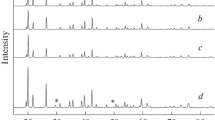Abstract
Lithium ion conductivity of lithium hexaoxozirconate Li8ZrO6 doped by Mg2+, Sr2+, Nb5+, V5+, and Ce4+ cations was studied using impedance spectroscopy. The NMR data indicate that in the low-temperature region, lithium ion migration takes place by exchange of Li+ among tetra- and octahedral positions. Data of Raman spectroscopy suggest that the potential reason for the sharp increase of Li8ZrO6 and its solid solutions’ conductivity near 700 K may be melting of LiOH which occurs as a result of interaction between samples and atmospheric moisture.





Similar content being viewed by others
Change history
17 July 2018
The authors are grateful to A. L. Buzlukov and I. Y. Arapov for performing the 7Li NMR experiments.
References
Cao С, Li ZB, Wang XL, Zhao XB, Han WQ (2014) Recent advances in inorganic solid electrolytes for lithium batteries. Front Energy Res 2. https://doi.org/10.3389/fenrg.2014.00025
Dumon A, Huang M, Shen Y, Nan CW (2013) High Li ion conductivity in strontium doped Li7La3Zr2O12 garnet. Solid State Ionics 243:36–41
Hong HY-P (1978) Crystal structure and ionic conductivity of Li14Zn(GeO4)4 and other new Li+ superionic conductors. Mater Res Bull 13(2):117–124
Aono H, Sugimoto E, Sadaoka Y, Imanaka N, Adachi G (1990) Ionic conductivity of solid electrolytes based on lithium titanium phosphate. J Electrochem Soc 137(4):1023–1027
Fu J (1997) Fast Li+ ion conducting glass-ceramics in the system Li2O–Al2O3–GeO2–P2O5. Solid State Ionics 104(3-4):191–194
Hellstrom EE, Gool van W (1981) Li ion conduction in Li2ZrO3, Li4ZrO4, and LiScO2. Solid State Ionics 2(1):59–64
Moiseev GK, Vatolin NA (2003) Interaction of lithium zirconate with lithium under equilibrium conditions. Dokl Phys Chem 388(4/6):33–37
Delmas C, Maazaz A, Guillen F, Fouassier C, Reau JM, Hagenmuller P (1979) Des conducteurs ioniques pseudo-bidimensionnels: Li8MO6 (M = Zr, Sn), Li7LO6 (L = Nb, Ta) et Li6In206. Mat Res Bull 14(5):619–625
Pantyukhina MI, Shchelkanova MS, Stepanov AP, Buzlukov AL (2010) Investigation of ion transport in Li8ZrO6 and Li 6Zr2O7 solid electrolytes. Bull Russ Acad Sci: Phys 74(5):653–655
Shchelkanova MS, Pantyukhina MI, Kalashnova AV, Plaksin SV (2016) Electrochemical properties of Li8 − 2xMxZrO6 (M = Mg, Sr) solid electrolytes. Solid State Ionics 290:12–17
Shchelkanova МS, Pantyukhina MI, Antonov BD, Kalashnova AV (2014) Produce new solid electrolytes based on the Li8-xZr1-xVxO6. Butlerov Commun (in Russian) 38:96–102
Pantyukhina MI, Shchelkanova МS, Plaksin SV (2013) Synthesis and electrochemical properties of Li8-xZr1-xNbxO6 solid solutions. Phys Solid State 55(4):707–709
Andreev OL, Pantyukhina MI, Martem'yanova ZS, Batalov NN (2003) Ionic conductivity and thermodynamic properties of solid electrolytes based on lithium orthozirconate. Electrochemical Energetic 3:86–90 (in Russian)
Pantyukhina MI, Andreev OL, Martem'yanova ZS, Batalov NN (2004) Cation conductivity of Li8ZrO6–LiYO2 solid solutions. Inorg Mater 40(4):404–406
Huang S, Fang Y, Wang B, Wilson BE, Tran N, Truhlar DG, Stein A (2016) Conduction and surface effects in cathode materials: Li8ZrO6 and doped Li8ZrO6. J Phys Chem C 120(18):9637–9649
Pantyukhina MI, Shchelkanova МS, Plaksin SV (2013) Electrochemical properties of solid solutions in the Li8Zr1-xCexO6 system. Russ J Electrochem 49(2):144–148
Pantyukhina MI, Shchelkanova МS, Plaksin SV (2010) Ionic conduction of Li8 - 2x Mg x ZrO6 solid solutions. Russ J Electrochem 46:831–834
Pantyukhina MI, Shchelkanova МS, Plaksin SV (2012) Ionic conductivity of Li8-2xSrxZrO6. Inorg Mater 48(4):382–385
PDF2 (JCPDS-ICCD) (Joint committee of powder diffraction standards)
Raistrick ID, Ho C, Huggins AR (1976) Lithium ion conduction in LiAlO4, Li5GaO4, and Li6ZnO4. Mater Res Bull 11(8):953–958
Ramdani A, Brice JF (1981) Etude des proprietes de conduction electrique du Ferrite Li5FeO4. Ann Chim 6:569–578
Nagano N, Greenblatt M (1987) Structural and electrical properties of Li5TlO4. Solid State Ionics 24(2):169–174
Muhle C, Dinnebier RE, van Wullen L, Schwering G, Jansen M (2004) New insights into the structural and dynamical features of lithium hexaoxometalates Li7MO6 (M = Nb, Ta, Sb, Bi). Inorg Chem 43(3):874–881
Ohno H, Konishi S, Nagasaki T, Kurasawa T, Katsuta H, Watanabe H (1985) Electrical conductivity of a sintered pellet of octalithium zirconate. J Nucl Mat 132(3):222–230
Biefeld RM, Johnson RT (1979) The effects of Li2SO4 addition, moisture, and LiOH on the ionic conductivity of Li5AIO4. J Solid State Chem 29(3):393–399
Johnson RT, Biefeld RM (1979) Ionic conductivity of Li5AlO4 and Li5GaO4 in moist air environments: potential humidity sensors. Mat. Res. Bull. 14(4):537–542
Pantyukhina MI, Andreev OL, Antonov BD, Batalov NN (2002) Synthesis and electrical properties of lithium zirconates. Russ J Inorg Chem 47:1630–1633
Scholder R, Räde D, Schwarz H (1968) Uber Zirkonate, Hafnate und Thorate von Barium, Strontium, Lithium und Natrium. Z Anorg Allg Chem Bd 362(3-4):149–168
Charton S, Maupoix C, Delaunay F, Saviot L, Bernard F (2016) Experimental investigation on lithium hydride hydrolysis. Thesis, Lyon (France), WHEC16
Brooker MH, Bates JB (1971) Raman and infrared spectral studies of anhydrous Li2CO3 and Na2CO3. J Chem Phys 54(11):4788–4791
Harbach F, Ficher F (1975) Raman spectra of lithium hydroxide single crystals. J Phys Cha Solids 36:60l–603l
Shannon RD (1976) Revised effective ionic radii and systematic studies of interatomic distances in halides and chalcogenides. Acta Cryst A32:751–767
Johnson RT, Biefeld RM, Keck JD (1977) Ionic conductivity in Li5AlO4 and LiOH. Mat Res Bull 12(6):577–587
Acknowledgments
The authors are grateful to S.V. Plaksin and E.G. Vovkotrub. The research has been carried out with the equipment of the Shared Access Center “Composition of Compounds” of the Institute of High-Temperature Electrochemistry of Ural Branch of RAS, Yekaterinburg, Russian Federation.
Author information
Authors and Affiliations
Corresponding author
Additional information
Highlights
Li8ZrO6 doped by M2+, A5+, and Ce4+ was studied using impedance, Raman study, and NMR. The maximum conductivity (9 × 10-6 S cm−1 at 476 К) is observed for Li7.98Zr0.98V0.02O6. Below 700 K, Li+ ions move via jumps between octahedral and tetrahedral positions. In all cases, conductivity shows a jump-like rise at 680–710 K. One of the reasons for a jump of conductivity near 700 K may be the melting of LiOH.
Rights and permissions
About this article
Cite this article
Shchelkanova, M.S., Shekhtman, G.S., Kalashnova, A.V. et al. Lithium ion conductivity of solid solutions based on Li8ZrO6. J Solid State Electrochem 22, 2959–2964 (2018). https://doi.org/10.1007/s10008-018-3993-0
Received:
Revised:
Accepted:
Published:
Issue Date:
DOI: https://doi.org/10.1007/s10008-018-3993-0



